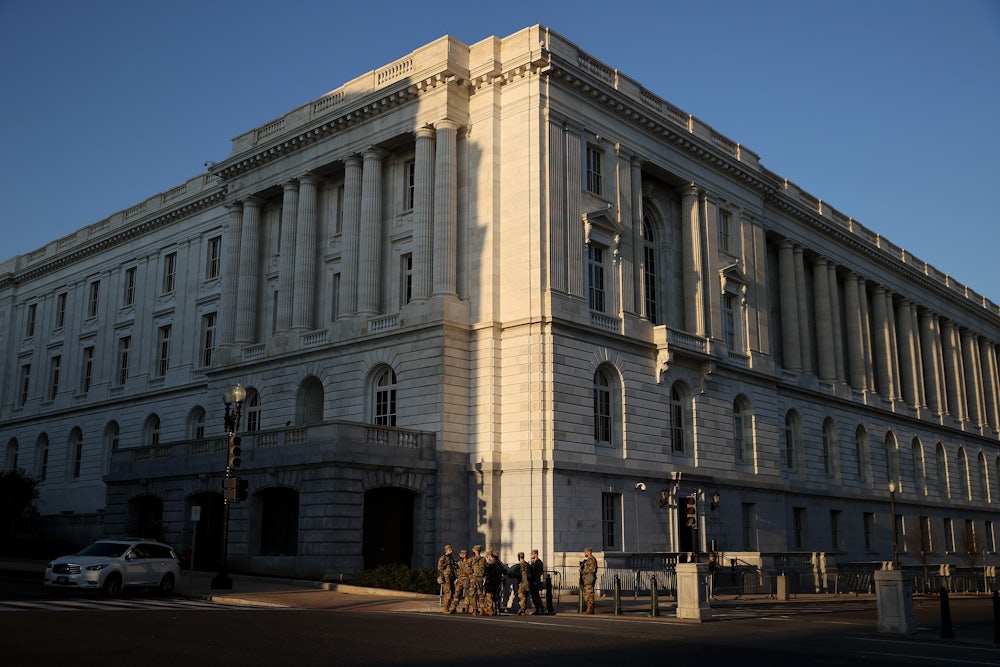More than 12,000 men and women have served in Congress since 1789. But only six have received the highest honor that Congress can bestow—to have their name on a Capitol Hill office building as an inspiration to future legislators. This illustrious group includes three powerful House speakers (Sam Rayburn, Nicholas Longworth, and Joseph Cannon); liberal Senate icon Philip Hart; and Republican Senate leader Everett Dirksen, who was a pivotal supporter of the 1964 Civil Rights Act. But the sixth figure in the group, Georgia Senator Richard Russell, is a national embarrassment.
In an era of renamings and heightened sensitivity to the moral failings of once celebrated figures, it is both baffling and troubling that the name of the most adroit segregationist of the civil rights era remains on the Russell Senate Office Building.
During Russell’s nearly four decades in the Senate, from 1933 until 1971, journalists consistently portrayed the Georgia senator as a pillar of integrity, an unchallenged master of the Senate’s arcane precedents, and a stalwart supporter of massive military spending to combat the Soviet Union. As Newsweek put it in a fawning 1963 cover story, “Senator Russell … is a courtly, soft-spoken, cultured patrician, whose aides and associates treat him with deferential awe. Modest, even shy, in manner, devastatingly skillful in debate, he has a brilliant mind [and] encyclopedia learning.”
Sounds like a model midcentury senator. Except for one thing: Whether he was filibustering an anti-lynching bill in the 1930s or trying to block the historic civil rights legislation in the 1960s, Russell was not just at the forefront of the segregationist Southern Caucus; he was its chief strategist. In Russell’s mind, the fight against civil rights was the Lost Cause of the Confederacy all over again, and he stood stalwart, like his hero Robert E. Lee.
When the 1964 Civil Rights Act finally passed, despite Russell’s 60-day filibuster, his fellow segregationist Senator John Stennis of Mississippi wrote him a letter of consolation: “Except for you and your fine leadership, a strong civil rights bill would have been passed—at least one with major provisions—as early as 1948 … or certainly soon after the unprecedented Supreme Court decision of 1954.”
Gilbert C. Fite, in his 1991 biography, calls the Stennis letter “an accurate assessment of Russell’s influence.”
Think of it. If it weren’t for Richard Russell, the United States would have had a strong civil rights bill immediately after World War II, or certainly following the Brown v. Board of Education decision. Justice was denied for nearly two decades—an entire generation of Black citizens—because of Russell’s legislative guile and inflated moral reputation. And this is the man whose name adorns a Senate office building.
Russell was able to wield as much power and influence as he did because he cultivated an image not as a demagogue, like some Southern senators, but as a principled believer in constitutional government and states’ rights. As Robert Caro writes in Master of the Senate, the third volume of his monumental Lyndon Johnson biography, Russell “convinced northern liberals that he was not a racist, that he didn’t hate the Negro, that he was a moderate who truly wanted progress in racial relations.”
Yet beneath that principled veneer, Russell had a belief system far cruder than his densely argued speeches about abstruse eighteenth-century constitutional theories would suggest. In Master of the Senate, Caro references a letter marked “Confidential,” in which Russell wrote, “Any southern white man worth a pinch of salt would give his all to maintain white supremacy.” By the late 1950s, according to the most charitable of biographers, Russell’s niece Sally, the senator “became increasingly anxious about what he called the ‘miscegenation’ or, less frequently, ‘mongrelization’ of America.” During the fight over the 1964 Civil Rights Act, Russell published a magazine article actually suggesting paying Southern Blacks to move to other regions of the country.
Throughout Russell’s Senate career, almost every decision he made or position he took, apart from his fervent belief in bringing more military bases to Georgia, was rooted in his fears of losing the comfortable, white-dominated world into which he was born, in 1897. As a hawk always calling for higher defense spending, Russell might have been expected to support statehood for Hawaii and Alaska as a way of projecting American power into the Pacific and to the edge of Siberia. Instead, Russell militantly opposed statehood because he calculated that the four new senators would vote with the north on civil rights.
And yet, when Russell died in 1971, even his old antagonists, such as liberal crusader Hubert Humphrey, successfully made the pilgrimage to Winder, Georgia, for his funeral. (Bad weather did ground the planes carrying 55 senators and Vice President Spiro Agnew, and they eventually had to deliver most of the eulogies through television hookup from Charleston, South Carolina.)
Russell’s death happened to occur just before the Senate was about to rename its two office buildings. They were then formally known by the smile-inducing monikers “Old S.O.B.” and “New S.O.B.” But plans for a third office building (later named for Hart) required a change in the nomenclature. So the Senate voted to name the newer of the two existing buildings after Dirksen (who had died in 1969), while it decided to give Russell, appropriately enough, the Old S.O.B.
A decision made in the emotional wake of Russell’s death should not be binding forever. Even in 1972, naming a building for the leader of the Southern Caucus was a misguided decision, emphasizing Russell’s cerebral style and courtly manner over the loathsome segregationist cause for which he had so long and stubbornly fought. If ever there were a building in Washington that cried out for a name change, it would be the Russell Building.
But what to call it instead?
When I first embarked on a crusade to strip the name plate off the Russell Building, I urged the Senate instead to honor Margaret Chase Smith, both for her place in history as the first woman senator of consequence and for her courage in taking on fellow Republican Joseph McCarthy before most others did. There is still much to be said for the Smith Senate Office Building. But an even a better choice would be to use the renaming ceremony to salute the maverick independence of John McCain, who, at the end of his career, with his dramatic 2017 Senate vote to save Obamacare, reminded the nation that principle trumps party, especially with a tinpot autocrat in the White House.








